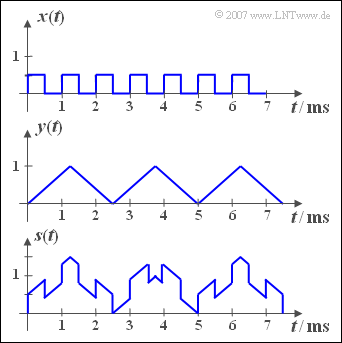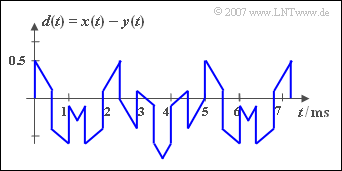Difference between revisions of "Aufgaben:Exercise 2.1Z: Sum Signal"
m (Oezdemir moved page Aufgabe 2.1Z: Summensignal to Exercise 2.1Z: Summing Signal) |
|||
| Line 4: | Line 4: | ||
[[File:P_ID319__Sig_Z_2_1.png|right|frame|Rechtecksignal, Dreiecksignal und Summensignal]] | [[File:P_ID319__Sig_Z_2_1.png|right|frame|Rechtecksignal, Dreiecksignal und Summensignal]] | ||
| − | + | The adjacent diagram shows the two periodic signals ${x(t)}$ and ${y(t)}$ , from which the sum signal ${s(t)}$ – sketched in the lower picture – and the difference signal ${d(t)}$ are formed. | |
| − | + | Furthermore, in this task we consider the signa ${w(t)}$, which results from the sum of the two periodic signals ${u(t)}$ und $v(t)$ . The base frequencies of the signals are | |
:* $f_u = 998 \,\text{Hz},$ | :* $f_u = 998 \,\text{Hz},$ | ||
| Line 12: | Line 12: | ||
:* $f_v = 1002 \,\text{Hz}.$ | :* $f_v = 1002 \,\text{Hz}.$ | ||
| − | + | That is all we know about the signals ${u(t)}$ and $v(t)$ . | |
Revision as of 00:36, 27 December 2020
The adjacent diagram shows the two periodic signals ${x(t)}$ and ${y(t)}$ , from which the sum signal ${s(t)}$ – sketched in the lower picture – and the difference signal ${d(t)}$ are formed.
Furthermore, in this task we consider the signa ${w(t)}$, which results from the sum of the two periodic signals ${u(t)}$ und $v(t)$ . The base frequencies of the signals are
- $f_u = 998 \,\text{Hz},$
- $f_v = 1002 \,\text{Hz}.$
That is all we know about the signals ${u(t)}$ and $v(t)$ .
Hinweis:
- Die Aufgabe gehört zum Kapitel Allgemeine Beschreibung periodischer Signale.
- Mit dem interaktiven Applet Periodendauer periodischer Signale lässt sich die resultierende Periodendauer zweier harmonischer Schwingungen ermitteln.
Fragebogen
Musterlösung
(2) Für das Dreiecksignal gilt $T_y = 2.5 \,\text{ms}$ und $f_y \hspace{0.15cm}\underline{= 0.4\, \text{kHz}}$.
(3) Die Grundfrequenz $f_s$ des Summensignals $s(t)$ ist der größte gemeinsame Teiler von $f_x = 1 \,\text{kHz}$ und $f_y = 0.4 \,\text{kHz}$.
- Daraus folgt $f_s = 200 \,\text{Hz}$ und die Periodendauer $T_s\hspace{0.15cm}\underline{ = 5 \,\text{ms}}$, wie auch aus der grafischen Darstellung des Signals ${s(t)}$ auf der Angabenseite hervorgeht.
(4) Die Periodendauer $T_d$ ändert sich gegenüber der Periodendauer $T_s$ nicht, wenn das Signal ${y(t)}$ nicht addiert, sondern subtrahiert wird: $T_d = T_s \hspace{0.15cm}\underline{= 5\, \text{ms}}$.
(5) Der größte gemeinsame Teiler von $f_u = 998 \,\text{Hz}$ und $f_{v} = 1002 \,\text{Hz}$ ist $f_w = 2 \,\text{Hz}$.
- Der Kehrwert hiervon ergibt die Periodendauer $T_w \hspace{0.15cm}\underline{= 500 \,\text{ms}}$.

